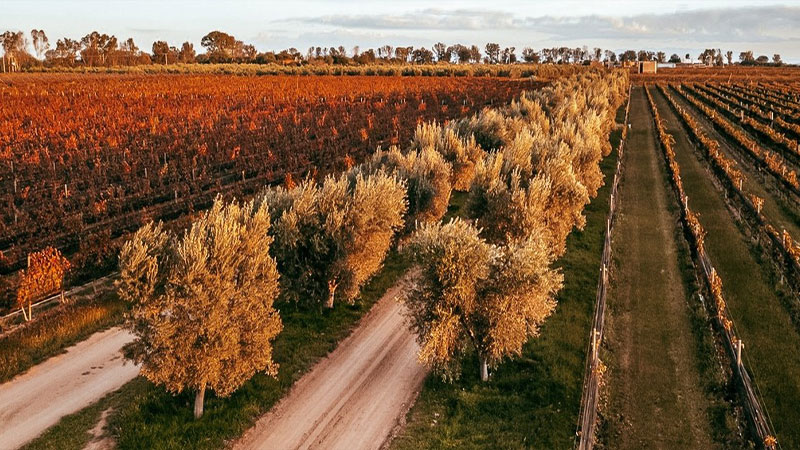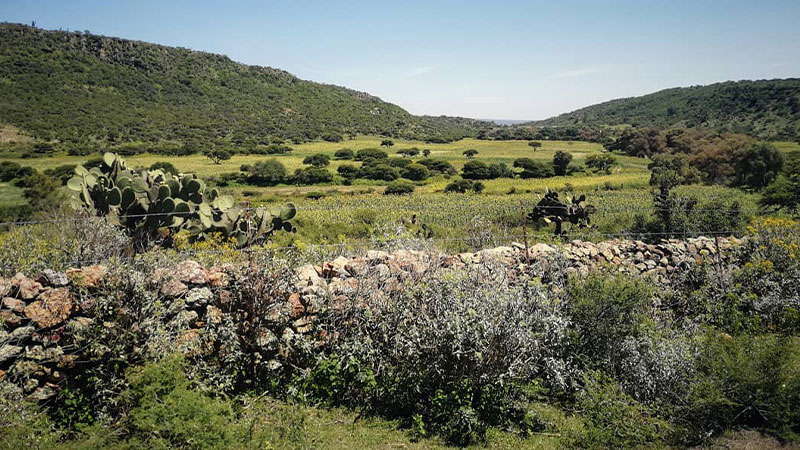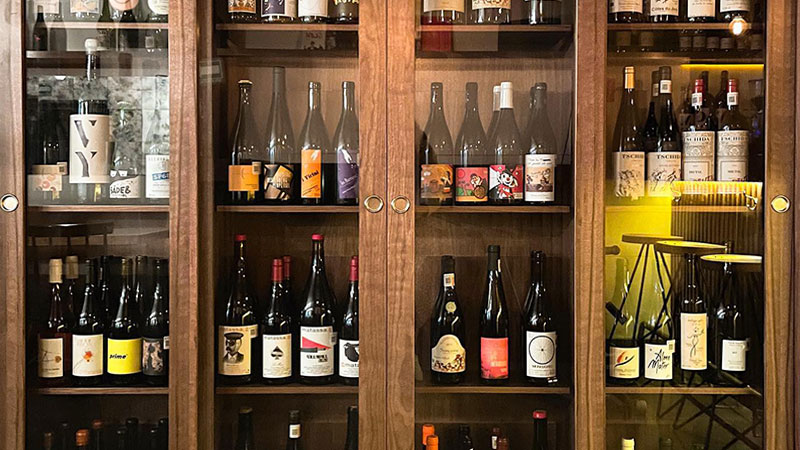Known primarily for its agriculture and the picturesque, expat-filled city of San Miguel de Allende, Mexico’s Guanajuato region is becoming one of the country’s most sought-after wine destinations. With just about 40 wineries, the region is already impacting and challenging the country’s relationship with wine.
Wine in Mexico has largely been reserved to the Coahuila and Valle de Guadalupe regions further north, which house storied brands like Casa Madero and L.A. Cetto. Yet, it hasn’t necessarily seen a large market inside or outside the country. Guanajuato, in particular, has received greater distinction for its agave distillates like tequila, featuring an entire Tequila Route and home to the renowned Casa Dragones distillery.
Guanajuato has always had an agricultural legacy, spanning beautiful ranchos and haciendas that produce corn, strawberries, and more. “There are a lot of people there that come from several generations of farming, which gives one patience. Wine is patience,” says Alberto Moyeda Carabaza, Mexican wine connoisseur and owner of Terruño, a wine bar in Mexico City. However, Mexico currently only produces about 30 percent of the wine it consumes, and it doesn’t yet have lobbying power as a consumer product. “They are mainly family projects, personal investments, or real estate projects,” says Moyeda Carabaza. “What’s happening in Guanajuato is that people invest their own land and property to make wine, because they like it.”
But to understand the recent popularity of viticulture in the Guanajuato region, it is first necessary to understand the history of wine in Mexico. Wine was first brought to the country by Spanish conquistadors looking to use it for religious ceremonies, particularly Sunday masses. The region’s pleasant weather and terrain allowed for several excellent winemaking regions — so much so that they threatened wine production in Europe, says Moyeda Carabaza. As a result, the Spanish burned the vineyards in Guanajuato, and commercial wine production was banned in Mexico for several centuries. The Mexican Revolution then led to hyper-nationalism and a rejection of all things Spanish — namely wine. And yet, during the French-Mexican War, quite a few dissidents stayed back, and wine production started to re-emerge in the Baja region first, primarily initiated by European communities in Mexico.

Guanajuato is a bit late to the game, with just under 20 years of winemaking under its belt. And yet it is setting a precedent for Mexican winemaking. At first look, Guanajuato was a destined wine region, particularly for its weather and terroir. This region’s high altitude compensates with latitude, its expansive plains and warm climes ensuring the grapes develop a thicker skin and higher levels of polyphenols. The semi-desert climate also lends to a more arid terrain with sandy soils, which are particularly great for drainage. Temperature differences of more than 20 degrees Celsius (68 degrees Fahrenheit) between day and night and a seasonal climate allow the region to sufficiently stress its grapes, resulting in intriguing, fresh flavors that go down with ease. Finally, a microclimate caused by the Foehn effect of being surrounded by mountains allows for varying conditions and terroir depending on the side of the mountain the vineyard sits on. The region produces excellent Sauvignon Blanc, Chardonnay, Pinot Noir, Sémillon, Cabernet Franc, and a few other varieties.
Cuna de Tierra was the first winery in the region, established in 2005. Its beginnings are linked to its Spanish heritage, first making brandy and homemade moonshine. Starting from just three barrels, the brand now holds more than 80 wine medals, including a 2022 Bacchus de Oro in Spain. It has also received high praise for its Sémillon white wine and the Lloro de Tierra that comes from a heritage family tradition. Beyond the wine itself, the winery has also been well regarded as an architectural project and awarded the Best Industrial Project at the Mexico City Architecture Biennial, Icons of Mexican Design by Architectural Digest magazine, and silver medal at the XIII Biennial of Mexican Architecture.
“Our wines try to reflect the quality and characteristics of this terroir without a price marketing strategy of rising prices for appearances,” says Francisco Lara Sirvent, a representative from the winery. “The future looks promising, and we find ourselves on a very exciting path of learning and developing new ways and promoting wine culture while improving Guanajuato’s people’s lives through tourism, specialized jobs in the farms, and pride.”

Viñedos Dos Búhos, meaning “two owls,” is the second-oldest winery in the region. What began as a passion project that started a fruit collective three generations ago now makes some of the most symbolic wines in the area and is one of just two certified organic wineries in the country. Today they are a family of distinct disciplines, from architecture to art and viticulture, joined together under a mutual purpose. “To be honest, I think the world doesn’t need more wines or vineyards,” says a family representative who prefers to remain unnamed. “It needs people and projects that aim to heal and repair the world. At Dos Búhos, we believe in better wines for a better world.” Their orange wine, anaranjado, is created following the ancient method: hiding it underground in stone or clay amphorae, where it ages for up to three years.
Garambullo is another such project. Founded by husband-and-wife team Branko Pjanic and Natalia López Mota, Garambullo is a natural, hand-harvested and -crafted winery with a tendency to experiment. “Our production style is a mixture of the traditional and the contemporary, always accompanied by curiosity and play,” says López Mota. “At the same time, the main axis that directs our work is the desire to maintain a space for oenological experimentation that evokes respect for the lineage of all those who have added value to the art that involves the transformation of wine.” The winery produces just 7,000 bottles a year, preserving its central ethos as a boutique winemaker.
Its wines are anything but classic or boring and certainly staples of Mexico City’s best wine establishments, ranging from Loup Bar to national wine store Vinos Chidos. One notable wine is Garambullo’s Rover Orange 2002, with a citrusy whiff on the nose alongside melon and apricot flavors.
While orange wine is far from the only appraised style in Guanajuato, it best shows the viticulture of this region as it requires specific organic production. The region, overall, is highly focused on natural production even though just one winery is certified organic by Oregon Tilth. Instead, out of sheer integrity, each winery chooses to utilize estate-grown, mostly organic grapes fermented with natural yeast and minimal intervention.

The post-pandemic years have been monumental for this region, which has historically been highly focused on artisanal handcraft, art, and textile tourism. In August, 2021, Guanajuato Ministry of Tourism announced a new initiative called Guanajuato, Tierra de Vinos, (Guanajuato, Land of Wine). The initiative aims to establish a series of travel experiences through the region’s 43 vineyards, which cover 385 hectares. This will include five different wine routes and harvest festivals. A wine museum was proposed as well. The region will specifically focus on sustainability in its efforts. “The link between sustainability and wine tourism makes Guanajuato a world benchmark,” says Juan José Álvarez, Guanajuato’s secretary of tourism.
“Mexico is the biggest exporter of beer, all the tequila, and mezcal,” says Moyeda Carabaza. “Mexicans, we’re good with alcohol. What we were missing was wine, so it was only natural that this would happen — we love to make quality alcoholic products.”
